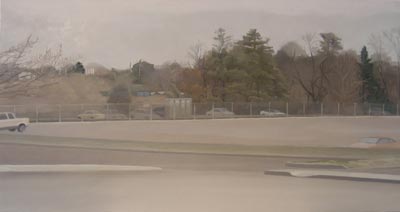
Life in the Slow Lane & Parking Lot
Paintings by Philip Geiger and Anna Hostvedt at Tibor de Nagy
By Maureen Mullarkey
IN 1837, PAINTER WILLIAM ALLSTON WROTE TO A FRIEND about the work of William Sydney Mount: “He has a firm, decided pencil, and seems to have a good notion of the figure.” Allston added: “If he would study Ostade and Jan Steen, especially the latter, and master their color and chiaroscuro, there is nothing … to prevent his becoming a great artist in the line he has chosen.”
Mount was a history painter who, sensitive to the antiheroic temper of the time, turned to genre scenes of everyday life. With a bit of tinkering, Allston’s comments could be applied to Philip Geiger currently exhibiting at Tibor de Nagy.
 |
| Philip Geiger, Woolen Mills, 2007 |
Mr. Geiger’s unpretentious household scenes continue the tradition of genre painting, a distinctly middle class art form that originated among seventeenth century Dutch and Flemish painters. It developed in tandem with that other middle class art form, the novel. An impulse to narrative drives them both.
Looking at Mr. Geiger’s work, it is not Vermeer that comes to mind, but George Eliot: “Mine is too often a world such as [David] Wilkie can so well paint, a walled-in world furnished with all the details he remembers … and the least interesting part thereof is often what I suppose must be designated the intelligent.”
Mr. Geiger places plebeian figures in a walled-in composition casually called the “Dutch box.” An inherited device, it features an unexceptional interior illumined and partly transfigured by a light source — through a door or window — from without. In Mr. Geiger’s handling, space is enlivened by light while the human figure is often fractured by it.
Two young women in “Close Music” (2006) sit at breakfast together in a composition beautifully unified by color chords — yellow in a range of saturations. The face of one girl and the anatomy of the other is splintered rather than shaped by the combination of roughened chiaroscuro and jagged brushstrokes. Many of the works on view treat settings with greater conviction — or is it sympathy? — than the people who inhabit them.
Mr. Geiger’s most appealing compositions build around a woman asleep. Here, the figure withdraws into the subdued light of an architectural frame where it escapes the ruptures of sharp lighting contrasts hastily brushed. “Woolen Mills” (2007) is particularly captivating. The image is divided in half by the edge of a wall. On one side, light streams from an open door; on the other, a woman lies on a cast iron bed. The iron work and its cast shadow have an impressionist shimmer that comlements the burst of pale pinks and whites of the robe and towels hanging on the illuminated door.
The artist depicts a plausible modern domesticity that pushes the quotidian toward the banal. In “Lift” (2006), a middle-aged man sits at a table, his back to a sketchy woman standing behind him. “Recede” 2006) features the same man in an arm chair watching a crawling infant. In each, he wears a rumpled sweat shirt and baseball cap turned sideways. The hero-in-decline, a staple in fiction since Victorian times, shows up in contemporary painting as a schlump.
Overall, these paintings appear not so much composed as caught in passing, snapshots from some stranger’s family album. At first sight, this is their charm. But it is also the point at which they lose resonance. Strangers are quite specific even though we do no know their names. In traditional genre painting, figures are types, signposts for something beyond themselves. Mr. Geiger’s figures, neither portraits nor types, linger in limbo.




Exhibiting simultaneously at Tibor de Nagy is Anna Hostvedt. She is a talented, knowledgeable painter who burrows into the dead center of the gray scale. This, her second show with the gallery, is as reticent as the first. The intelligence she brings to her craft deserves notice. The pleasure of it is less immediate.
 |
| Anna Hostvedt, From Northeast by East, 2007 |
Ms. Hostvedt paints on site in the commuter parking lot at the LIRR station in Ronkonkoma. Her small panels [8 by 10 and/or 16 inches] are delicately handled but there is just not much to see in a parking lot. It is a dull subject that banks completely on compositional design. Happily, she is a good designer. Her capabilities are evident in the horizontal panels which give landscape elements room to breathe and downplay the empty parked cars.
“From Northeast by East” (2007) scans across the parking to a rise that is barren of greenery on one end, planted with trees on the other. A barely perceptible hint of russet foliage meets the eye in the center of the view. It is as close to an accent as Ms. Hostvedt permits herself to come. Almost achromatized, the faded color holds just enough warmth to enliven what could easily become a bloodless formula.
Bleached tones suit the subject of “Bearing Northwest” (2007). Here, fallen snow has been cleared from the lot, plowed into successive rows. The composition is a series of horizontals that roll backward, over the snow, over the roofs of cars and the tops of houses until the eye rests on a hueless expanse of sky.
“North by Northwest” (2007) is another successful lateral design. A straight causeway bisects the composition, separating a light colorless sky from an ashen foreground that is most likely marsh. (Without color cues, you find yourself guessing.)
Ms. Hostvedt’s matte surfaces are lovely but her images are so pallid as to be almost absent. Scenes might blow off the panel at the first gust of wind.




“Philip Geiger: Recent Paintings” and “Anna Hostvedt: New Paintings” at Tibor de Nagy Gallery (724 Fifth Avenue, 212-262-5050).
These reviews first appeared in The New York Sun on October 11, 2007.
Copyright 2007, Maureen Mullarkey







